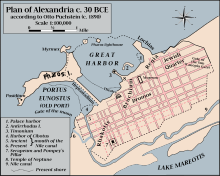Antirhodos
 Map of ancient Alexandria. "2" marks the island of Antirhodos. | |
| Location | Alexandria |
|---|---|
| Region | Egypt |
| Coordinates | 31°12′24″N 29°54′01″E / 31.20667°N 29.90028°E |
| Altitude | −5 m (−16 ft) |
| Type | Island |
| Part of | Alexandria Port |
| Length | 300 metres (980 ft) |
| Area | 500 ha (1,200 acres) |
| History | |
| Founded | c. 250BC |
| Cultures | Ptolemaic Kingdom |
| Associated with | Cleopatra |
| Site notes | |
| Excavation dates | 1996 |
| Archaeologists | Franck Goddio |
| Condition | Submerged |
Antirhodos (sometimes Antirrhodos or Anti Rhodes) was an island in the eastern harbor of
Descriptions of the island were recorded in classical antiquity by Greek geographers and historians. Strabo described a royal house on Antirhodos in 27 BC[3] and wrote that the island's name ("counter-Rhodes") derived from the island's rivalry with the island of Rhodes.[4] Antirhodos was part of Alexandria's ancient royal port called the Portus Magnus, which also included parts of the Lochias peninsula in the East and the island of Pharos in the West.[5] The Portus Magnus was abandoned and left as an open bay after an earthquake in the 8th century.
Rediscovery
In 1996, underwater archaeology in the harbour of Alexandria conducted by Franck Goddio[6] located the island and found that it was on the opposite side of the harbour from where it was placed by Strabo.[7] The excavations showed that the island had been occupied from before the founding of Alexandria and that it was totally levelled and prepared for construction around 250BC.[3]
The island was small (about 500 hectares or 1,200 acres) and fully paved,[8] with three branches leading in different directions. The main branch was 300 metres (1,000 ft) long and had an esplanade facing the site of the Caesarium temple on the mainland seafront.
On the esplanade Goddio uncovered the remains of a relatively modest (90 metres by 30 metres) marble-floored 3rd century BC palace, believed to have been Cleopatra's royal quarters. On another narrow branch of the island there was a small Temple of Isis which had at its entrance a life-size granite statue representing a shaven-headed Egyptian priest of the goddess Isis carrying a jar topped with an image of Osiris.[9] A pair of granite sphinxes flanked the statue, one of which had the head of Cleopatra's father.[2][10]
Between the branches on the eastern side of the island there was a small port with docks.[1] Here there was a series of 60 columns, each 1 metre in diameter and 7 metres in length, made of red Egyptian granite and topped with a decorated crown. Ancient paintings indicate that the columns acted as the ceremonial gateway to the island.[11] The wreck of a 30-metre long 1st century BC or 1st century AD Roman ship has been identified in the vicinity of the port.[12] Evidence from a hole in the ship's hull suggests that it could have sunk after being rammed by another boat.[2]
The site of
-
1743 map of Alexandria showing "R. Supposed site of the isle Antirrhodes"
-
Bust of Cleopatra currently on display at the Royal Ontario Museum, Toronto. The bust is believed to have been discovered at the royal palace on Antirhodos.
-
White marble torso of Hermes discovered on the southern branch of the Island of Antirhodos. (Grand Palais exhibition, 2006)
References
Citations
- ^ a b "Expositions (Grand Palais, Paris, 2006-2007): Trésors engloutis d'Égypte" [Exhibition (Grand Palais, Paris, 2006-7): Egypt's Sunken Treasures]. www.bubastis.be (in French). 2007. Retrieved 16 August 2015.
- ^ a b c "Sphinx of Cleopatra's father emerges from waves". CNN News. 29 October 1998. Retrieved 15 August 2015.
- ^ a b c Vizard, Frank (May 1999). "In Search of Cleopatra's Palace". Popular Science. 254 (5). Retrieved 16 August 2015.
- ^ Strabo. "The Geography of Strabo: Book XVII". The University of Chicago. Bill Thayer. Retrieved 23 July 2015.
They so called it as being a rival of Rhodes
- ^ Smith, William. Dictionary of Greek and Roman Geography. London: Walton and Maberly. p. 27. Retrieved 23 July 2015.
- ^ "Sunken Civilizations: Alexandria". Franck Goddio. Archived from the original on 27 September 2021.
- ^ Michael Sedge. "Cleopatra's Sunken Palace". Virtual Egypt. Retrieved 15 August 2015.
- ^ Mirsky, Steve (31 January 2010). "Cleopatra's Alexandria Treasures". Scientific American. Retrieved 16 August 2015.
- ^ "Priest with Osiris-Canopus object study" (PDF). Franck Goddio Underwater Archaeologist. Retrieved 5 December 2022.
- ^ "Sphinx from Alexandria's Portus Magnus object study" (PDF). Franck Goddio Underwater Archaeologist. Retrieved 5 December 2022.
- ^ Atif, Wessam (20 November 2013). "Diving into Egyptian History: The Rediscovery of Cleopatra's Sunken Palace and Diving it Today". Underwater Photography Guide. Retrieved 16 August 2015.
- S2CID 162781243.
- ^ "Colossal head of Caesarion object study" (PDF). Franck Goddio Underwater Archaeologist. Retrieved 5 December 2022.
Bibliography
- University of Oxford Live 2021, "The Portus Magnus of Alexandria: 25 years of underwater archaeological research" lecture by Franck Goddio
- Puchstein, Otto (1894). "Antirrodos". Paulys Realencyclopädie der klassischen Altertumswissenschaft [Pauly's Real Encyclopedia of Classical Antiquity] (in German). Vol. 1&2. Stuttgart.
{{cite book}}: CS1 maint: location missing publisher (link) - "Herrscher der bewohnten Erde" [Ruler of the Inhabited Earth]. Der Spiegel (44). 27 October 1997. Retrieved 23 July 2015.
- Goddio, Franck; Fabre, David, eds. (2008). Egypt's Sunken Treasures (Exhibition Catalogue) (2nd ed.). Munich: Prestel. ISBN 978-3-7913-3970-2.
- Robinson, Damian; Wilson, Andrew, eds. (2010). Alexandria and the North-Western Delta. Oxford: Oxford Centre for Maritime Archaeology. ISBN 978-1-905905-14-0.
- Bernard, A.; Bernand, E.; Yoyotte, J.; Goddio, F. (1998). Alexandria, the submerged royal quarters. London: Periplus Publishing. ISBN 1-902699-00-9.



